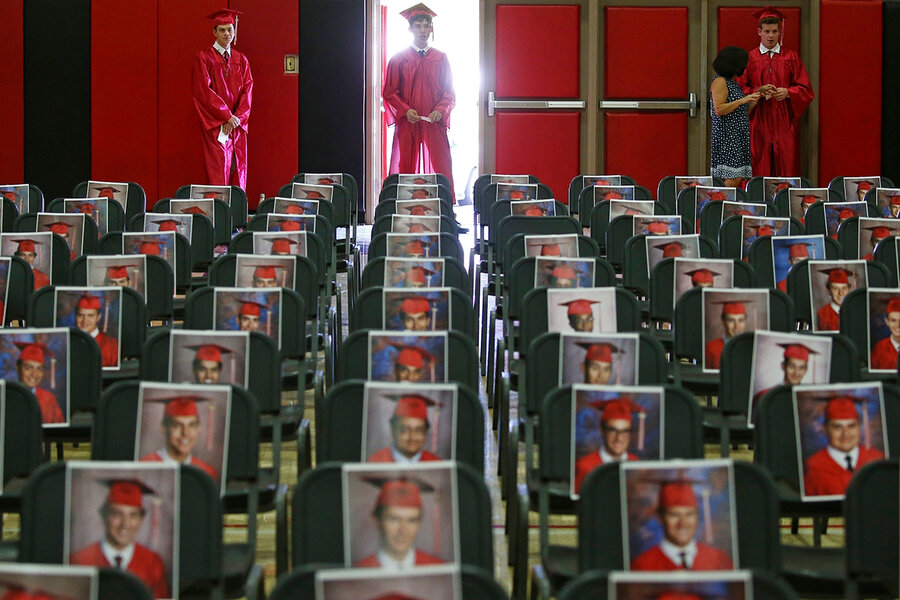Saving the 'lockdown generation' from being locked out
Loading...
| London
When it comes to the lockdowns ordered to combat the pandemic, young people are bearing the brunt.
Schools, universities, and technical institutes have suspended their classes, or at best switched to distance learning methods over the internet. With 1 billion students missing school, United Nations Secretary-General António Guterres warned this week of a “generational catastrophe.”
Why We Wrote This
The pandemic has plunged all of us into uncertainty. But perhaps the hardest hit are young people just starting out, putting new pressures on governments to support education and training.
But the key problem is employment. The global economic slump is destroying all sorts of jobs everywhere, but particularly the sort of casual positions that young people take when they are just starting out. Businesses are having a hard enough time keeping their existing staff on, without hiring inexperienced youth.
The International Labor Organization is worried about the long-term impact on what it calls the “lockdown generation” if their first forays into the job market are fruitless. Post-pandemic economic recovery plans, the U.N. body says, must support the kinds of businesses that offer job opportunities to youth.
The term “generation gap” has a long history, dating back to the flower-power days and anti-war protests of 1960s America. But COVID-19 has given it a new meaning – with potentially life-changing implications for millions of young people around the world.
The meaning of this COVID-19 generation gap is now becoming increasingly clear to politicians and policymakers: Young people have suffered disproportionately – socially, personally, educationally, and above all economically – from the lockdowns that governments have ordered to keep the pandemic at bay.
That generational peril has so far been overshadowed in a public debate that has focused on the fact that young people are less likely to suffer severely from COVID-19, and on the reluctance of some to take precautions like masking and social distancing.
Why We Wrote This
The pandemic has plunged all of us into uncertainty. But perhaps the hardest hit are young people just starting out, putting new pressures on governments to support education and training.
Criticism of this youthful insouciance in the United States and other economically advanced countries does carry echoes of the 1960s-era generation gap. “Narcissistic, entitled, spoiled” – those adjectives were the very ones used in an iconic cover story, “The Generation Gap,” published in Life magazine way back in the spring of 1968.
There are signs, though, that the political focus is shifting to the long-term price young people might have to pay for the pandemic’s social and economic dislocations.
Losing jobs, losing friends
These vary from country to country. In less developed countries, especially those with large numbers of young people, the effects could prove especially dire. In North Africa, for instance, the average age is barely 25. According to the Organization of Economic Cooperation and Development, about one-third of young North Africans were unemployed even before the coronavirus struck.
Many of those who did have work – in that region and worldwide – were doing informal jobs. Those are the first kind to disappear in any economic downturn.
And given the scale of the worldwide economic slowdown due to the pandemic – the worst since the Great Depression – these young people are at risk of losing their jobs and livelihoods altogether.
In the U.S. and some other developed countries, there is also mounting concern about both the economic impact and the broader social and psychological effects of the pandemic on young people.
Teenagers have had to curtail or even eliminate face-to-face interactions with their friends at a time in their lives when such connections are key to personal growth. High schools, universities, and technical training institutions have been disrupted. And as COVID-19 makes a comeback, even in countries that successfully turned back the first wave of infection, it is unclear when students will be able to return to their classrooms.
United Nations Secretary-General António Guterres this week sounded a warning of a potential “generational catastrophe” in education. Last month more than 1 billion young people in some 160 countries had been affected by COVID-19-related school closures, he pointed out.
And the picture seems equally daunting when it comes to jobs.
A shadow for life?
A generation of young people leaving school, college, university, or technical courses has found itself in limbo. Before COVID-19 struck, they would have been taking their first steps into the job market, but traditional sources of first-time employment – service outlets like restaurants or shops – have been among the hardest hit by the economic shutdowns. Other businesses have found it hard enough to keep their existing staff, without making new hires.
In Britain, a leading economic think tank is predicting youth unemployment will more than double this year, rising to more than 1 million. Speaking to parliamentarians last week, the chief economist of the Bank of England called youth unemployment the largest risk to the prospects of a post-pandemic recovery.
Sharing this concern, the U.K. government has announced a $2.5 billion program, dubbed Kickstart, paying employers to provide six-month work placements for young people.
Yet it’s still not clear whether such programs can head off the potential long-term effects on young people’s lives, especially if the pandemic continues to force shutdowns or delay the prospect of a recovery.
A survey by a group called The Global Initiative for Decent Jobs for Youth – part of the International Labor Organization – found that 1 in 6 young people had lost their jobs since the pandemic began. One-quarter of those who still had jobs said their hours had been cut back. Half of the students surveyed said they anticipated a delay in finishing their studies. One in 10 expected to have to abandon education altogether.
Overall, more than half of those surveyed reported feeling anxious or depressed. Indeed, a young person’s first foray into the world of work often defines his or her working life. Early experience of joblessness can make the prospect of long-term, stable employment less likely.
There is a danger, a recent ILO report warned, that the “lockdown generation” will survive the pandemic only to be “scarred throughout their working lives.”
If that is to be avoided, say the ILO and a range of youth charities and policy groups, governments around the globe will have to ensure that their post-pandemic recovery packages include money for reviving and improving education and training – what the U.N. secretary-general this week termed “inclusive, resilient, quality education systems fit for the future.”
And they will also have to support businesses with particular potential to provide new jobs for young people, to help them get their feet on the first rung of the employment ladder.










